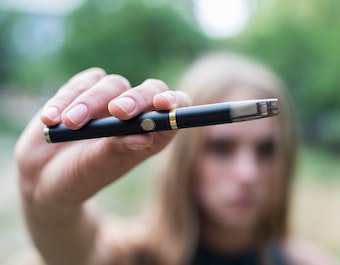For years, the number of people who smoked was headed in the right direction — down, down, down. In 2018, 13.7% of American adults smoked, compared with 20.9% just 13 years earlier, in 2005. Go back to 1965 and a whopping 42.4% of the American adults smoked.
Decades of campaigns about the dangers of smoking and laws to make it more expensive and less convenient, seemed to be paying off. But the use of one tobacco product has skyrocketed recently, especially among young people. The surgeon general has declared teen vaping an epidemic, threatening to ensnare a generation in nicotine addiction.
In 2011, just 1.5% of high school students reported using an electronic cigarette in the past 30 days. In 2019, that percentage was 27.5%, according to the 2019 National Youth Tobacco Survey. Between 2018 and 2019 alone, the number of middle and high school students who reported using e-cigarettes in the past 30 days increased from 3.6 million to 5.4 million.
New exposure to nicotine
Many experts worried that a new group of young people were becoming or would become addicted to nicotine. And it might not just be from e-cigarettes. Some research, such as a 2018 study in Pediatrics, is beginning to show that e-cigarette use may lead to smoking traditional cigarettes.
Many people, though, aren’t aware that almost all e-cigarettes contain nicotine, says Linda Richter, PhD, director of policy research and analysis at the Center on Addiction. A recent Centers for Disease Control and Prevention (CDC) study found that 99% of all e-cigarette products being sold contained nicotine, even some that claimed to be nicotine-free. In fact, one top e-cigarette brand’s entire product line contains nicotine — with one pod containing as much nicotine as 20 cigarettes. Nicotine is highly addictive, and younger brains are especially susceptible to nicotine addiction, which ups the risk of addiction to other drugs later on.
But when teens were asked in a study what was in their e-cigarettes, 66% said “just flavoring,” 13.7% said they weren’t sure, 13.2% said nicotine, and 5.8% said marijuana. That confusion about the safety of e-cigarettes is understandable. Since the time e-cigarettes first came on the market, companies have branded their products as an alternative to cigarettes, implying they are safer, Richter says.
“Cigarettes are one of the most harmful things you can use, so something being slightly less harmful is not the same as being harmless,” she says. As Scott McIntosh, PhD, associate director of the Smoking Research Program at the University of Rochester’s Wilmot Cancer Institute, once put it, vaping instead of smoking “is like switching from jumping out of a window on the eighth floor to jumping out of a window on the fourth floor.”
It’s true that e-cigarettes contain fewer chemicals than traditional cigarettes, but along with nicotine, the aerosol e-cigarettes produce also has been found to contain cancer-causing chemicals and heavy metals. Many flavored vaping liquids also contain diacetyl, a chemical that has been linked to lung disease.
And recently the CDC has tied more than 2,700 hospitalizations and more than 60 confirmed deaths to e-cigarette or vaping associated lung injury (EVALI). A vitamin E acetate added to some THC-containing vaping devices is closely associated with EVALI, although other substances and products are still being investigated.
“Despite the vaping-related lung illnesses, the fact that the number of kids vaping continues to go up is very concerning,” Richter says.
The use of e-cigarettes to vape cannabis has risen rapidly, too. From 2018 to 2019, the percentage of high school seniors who said they vaped cannabis in the past month increased from 7.5% in 2018 to 14% in 2019, according to the National Institutes of Health’s 2019 Monitoring the Future survey.
Evolution of e-cigarettes
Changes in the design and nicotine content of e-cigarettes means young people are able to vape more often and are taking in more nicotine when they do, Richter says. When e-cigarettes first came on the market, most looked like traditional cigarettes. Today, they look like everything from pens to watches, or they have a tank system, which means they can be refilled with what’s known as e-liquid. One popular e-cigarette maker, which 59.1% of high school students reported as their brand-of-choice in a 2019 JAMA study, manufactures vapes that resemble USB drives.
“It’s very hard to smoke cigarettes indoors,” Richter says. “Vaping can happen much more frequently. It’s happening in school bathrooms and hallways, it’s happening everywhere.”
And although teens hide vaping from adults, they aren’t embarrassed or hiding it very much from each other, Richter says. There’s much less stigma attached to vaping in comparison to smoking because of the perception of it being less harmful, she says. Teens who don’t vape every day especially consider that to be the case. In the 2019 National Youth Tobacco Survey, when asked which tobacco products they perceived as causing no harm or little harm based on intermittent use (some days, but not every day), 28.2% said e-cigarettes, compared with 9.5% for cigarettes.
But e-cigarettes have actually become more dangerous in recent years. Many now contain nicotine salts, instead of nicotine freebase, which allows for a higher concentration of nicotine to be absorbed more quickly and inhaled less harshly, according to the National Cancer Institute.
A JAMA study found that 21% of high school students who currently vape do so daily, and 34% reported vaping 20 or more days a month. The more young people who vape, the more socially acceptable it becomes, says Cheryl Lee, MD, a hospital-based physician in internal medicine and pediatrics at Chicago’s Northwestern Memorial and Lure Children’s Hospitals. And the fact that a friend or family member vapes is the second most common reason (behind curiosity) as to why young people say they vape, according to the 2019 National Youth Tobacco Survey.
E-cigarettes with flavoring are also a common reason that teens start to use e-cigarettes. Of the middle and high school students who have tried e-cigarettes, 69.6% have tried a flavored tobacco product, according to the 2019 National Youth Tobacco Survey. Nearly a quarter of high school and middle school students said flavors like mint, candy, fruit, or chocolate were the reason they tried it.
“The flavorings make it especially easy for people to ingest much more nicotine than they realize because it masks the taste,” Lee says.
In January 2019, the FDA announced that they planned to prevent e-cigarette companies from selling any pre-filled flavored cartridges aside from menthol or tobacco. But disposable e-cigarettes can still be sold in flavors like fruit or candy. Vape shops also can sell flavored e-liquids for refillable tank-based devices.
KATE ROCKWOOD
Rally Health





